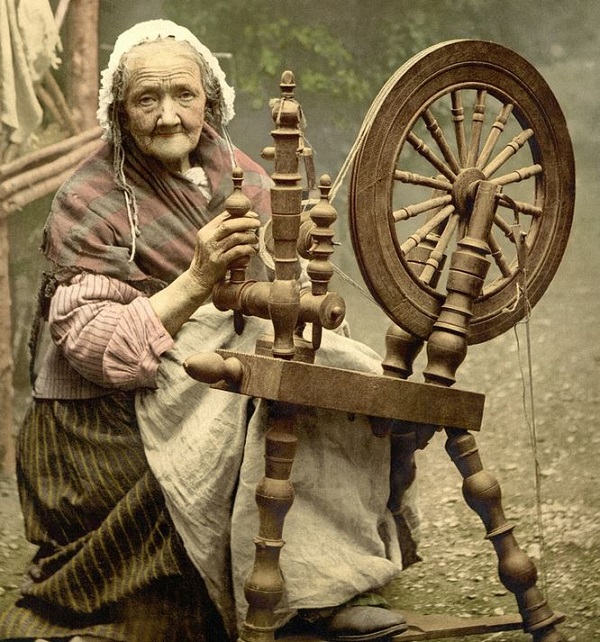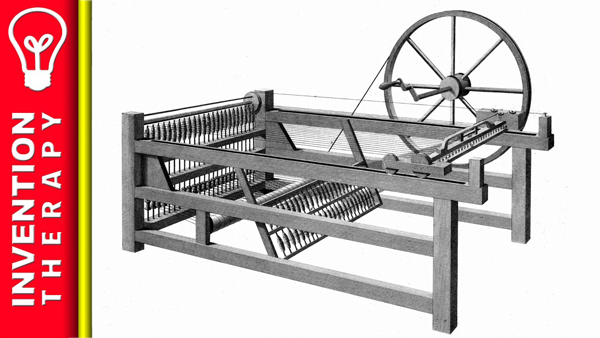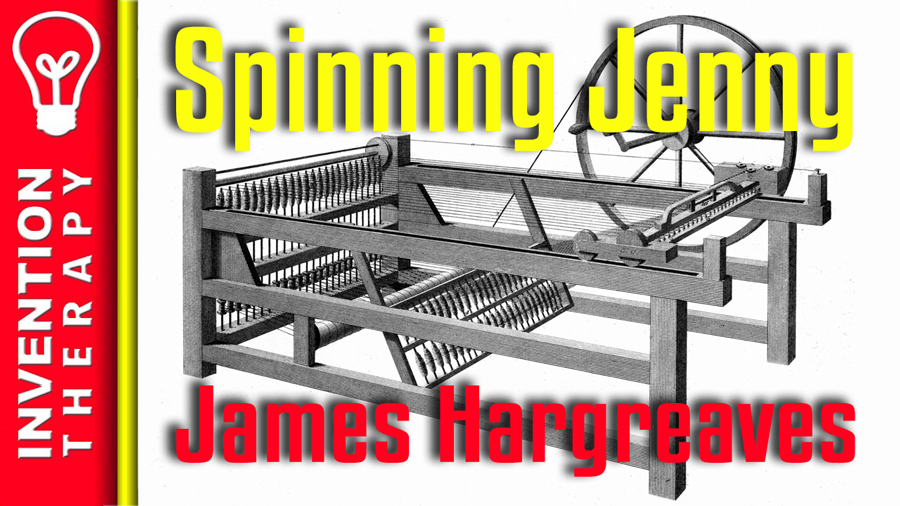James Hargreaves’ Spinning Jenny was one of the most important inventions of the 18th century that massively improved the weaving industry, and that signaled the onset of the Industrial Revolution. After John Kay’s Flying Shuttle, Hargreaves’ Spinning Jenny is one of the essential improvements to weaving machinery at the time. Not everyone accepted his invention when introduced.
Before James Hargreaves’ Spinning Jenny, most of the work occurred was done by hand. The weaving process was significantly slower and demanded much more attention from the workers. The Spinning Jenny industrialized the weaving industry and enabled a production on a mass scale.
James Hargreaves was the first inventor responsible for developing the spinning mechanism that would revolutionize the textile industry. His concept was later built on and improved by many subsequent inventors: most notably, Richard Arkwright and Samuel Compton.
The modest life of a revolutionary
What was the life of James Hargreaves, one of the most revolutionary people in history? How did he invent the spinning wheel? Hargreaves was not like some other inventors from the 18th century, who were well-educated or came from prominent families.
James Hargreaves was born in 1720 in Oswaldtwistle in Lancashire, United Kingdom. He lived in a region where industrialization was beginning to happen which meant that many inventors came from this area. Manual work was still the predominant way of working but this would change drastically in the 18th century thanks to inventors like Hargreaves. While we do not know much about the early life of James Hargreaves, he was a part of the working class.

James Hargreaves’ early life
Hargreaves was born into a working-class family. He began laboring as a handloom weaver at a very young age. Hargreaves was not an educated man – he received no formal education, which was quite common at the time. This was not a rarity in the early 18th century, as many people could not afford it. But even with little education, he was always very interested in engineering and improving the things around him.
Surprisingly still, Hargreaves could not read nor write. His family was poor, which is why he had to start working very early. There was no time to educate himself, as James had to help his family earn enough to survive. He worked as a talented weaver for most of his life. The work he did and all the skills he had he taught himself.
Fortunately, James was determined to learn the skill of weaving. He was also very interested in engineering from an early age and was always curious about how things worked. This sort of thinking inspired him to invent the spinning jenny.
Work and family in the textile industry
For most of his life, James Hargreaves worked in the textile industry. He was very competent at using a handloom. The majority of the population in his town was involved in the textile industry one way or another. Even the children and women of the towns worked in this industry. Lancashire, in general, was a very productive place in England before the Industrial Revolution.
Another famous inventor, John Kay, originated from a town nearby. Kay was also involved in the weaving industry and invented the flying shuttle. It is possible that Hargreaves got his inspiration in some way by Kay, who was active many years before Hargreaves patented his idea.
Hargreaves knew that the loom equipment of the time was not able to keep up with the demands of factory workers and merchants. As the supply requirements grew, more and more production output was necessary. Hargreaves and his coworkers struggled to meet those needs.

Many workers were starting to get frustrated and something needed to change. The flying shuttle was only the first step in the industrialization; many more inventions would improve weaving machinery, including James Hargreaves’ Spinning Jenny.
It was at this time that Hargreaves married Elizabeth Grimshaw, and they had 13 children. The family lived in a small home in Stanhill. James had to do a lot of work to support his family; the wages were measly, so they lived a mediocre life. This could also be the reason he was inspired to become an inventor.
The right place at the right time
The story behind Hargreaves’s getting the idea for the Spinning Jenny is quite a bizarre one. It was a typical day for Hargreaves, working hard on his handloom for most of the time. During those days, Hargreaves was one of the rare people that owned a handloom at their homes. But that was the day that would turn out to change his life.
To better understand how Hargreaves came to the idea of the Spinning Jenny, we must first take a look at how handlooms operated were before this invention. Weaving had already been industrialized to some extent, but many people were still using looms in their homes. Weaving and spinning was a cottage industry in many ways. A loom had to be operated by up to seven people – one person for spinning, three for providing the roving, and three to give the yarn for the spinner. Hargreaves’ family members likely helped him with this task. The loom used a spinning wheel with a single thread and a spindle that collected the yarn.
Hargreaves was hard at work in 1764 when suddenly, his daughter inadvertently overturned the spinning wheel on the floor. That is the moment of inspired genius for Hargreaves. When the loom was toppled on its side, the spinning wheel kept spinning. At the time, a common misconception was that the wheel stops revolving if it was not in a horizontal position. James saw an opportunity to add additional spindles to the spinning wheel and place them in a vertical position.
James Hargreaves’ Spinning Jenny
This minor accident was to be the moment that would change Hargreaves’ life and the textile industry forever. James saw the opportunity to improve the spinning wheel massively. Adding more spindles would allow for the use of additional yarn. More fabric could then be produced. This improvement significantly reduced the need for workers.
It is believed that the machine was named after his daughter Jenny, that overturned the spinning wheel. Other people think that the name means the “spinning machine,” as the word “jenny” is a slang word for the “engine” in British English.

Hargreaves originally created a new machine for his use initially. The Spinning Jenny was built with a metal frame where a spinning wheel would rest. The spinner had to manually move the spinning wheel with his right hand, causing the eight or more threads to rotate through the spindles. There were now eight spindles in the Spinning Jenny, compared to just a single one beforehand. James Hargreaves’ Spinning Jenny was a very revolutionary design which would be improved later on – eventually, there would be 120 spindles used, allowing for even more productivity.
This invention may have been a stroke of luck for James but he also sought solutions to simple problems. This story has a lesson for all of us as inventors – always look for inventions, even in the modest or simplest of places.
From local to international demand
Initially, Hargreaves designed the machine for his use and to support his own family. He soon saw the profits rise quickly and knew that his invention was going to be a great success. His productivity increased significantly, in addition to his earnings. The only downside of the new device was that the fabric that it produced was still quite low in quality and not very cohesive. It was eventually improved by adding more spindles to the machine.
Hargreaves started selling the product to neighbors and other handloom users within the local community. The results were astounding as many people saw the profits increase significantly. More and more yarn started to be used, the Spinning Jenny spread like wildfire. Many more people craved for this machine. As the popularity of the device grew, the prices for yarn started to drop dramatically.
As demand for workers decreased, more and more manufacturers started using his design. Like the robots of our time, consequently, many people lost their jobs due to this invention. Spinners were soon up in arms. Yarn makers were also not happy; the situation only slightly improved for them with increased production. Manufacturers were pleased with the invention, but the spinners who lost their jobs were not.
Hargreaves was soon under a lot of pressure from spinners. He received many threats at that time; it all escalated in 1768 when a group of spinners broke into his home, destroyed his equipment, and many Spinning Jennys. After this, he decided to relocate to Nottingham, where he would be able to work on his inventions.
Move to Nottingham and his patent
Hargreaves moved to Nottingham in 1768. He started looking for potential business partners and also sought to improve the Spinning Jenny. He found a partner in Thomas James. Their collaboration was profitable as they established a mill where they would test and improve their new devices.
In 1770, Hargreaves filed a patent for a version of the Spinning Jenny that had 16 spindles. He secured this patent to recoup the money he lost when manufacturers used his design illegally. Hargreaves took the infringing people to court but they offered him a large sum of 3000 British Pounds to settle the matter first. He refused, and he ended losing the case because he had already sold too many machines in what now what be known as a “prior art” patent claim. As a result, the Spinning Jenny never received a patent approval.
The legacy of the Spinning Jenny
The spinning Jenny would prove to be one of the most important inventions that would bring on the Industrial Revolution. It revolutionized the textile industry by improving the speed of work, decreased the number of workers, and increased productivity. The machine received many subsequent improvements later; at the start, it used eight spindles but was improved to use 16, 24, 80 and eventually, 120. Because this invention was not patented, many people tried to stake a claim as the inventor. Richard Arkwright made one of those claims because he designed the water frame, which helped the Spinning Jenny work more effectively.
Conclusion
James Hargreaves’ Spinning Jenny turned out to be one of the essential inventions that sparked the Industrial Revolution. It provided a basis to work on and further improve many machines in the textile industry.
What can we learn from James Hargreaves’ Spinning Jenny and his life?
- Look for inspiration from ordinary things.
- Understand the equipment that is already in use.
- Examine the market.
- Know where something can be improved.

Are you ready to become an inventor?
Getting your idea out of your head and into your hands is only the first in a long set of steps towards becoming a successful inventor.

First Steps To A Successful Invention
At Invention Therapy, we believe that the power of the internet makes it easier than you think to turn your invention idea into a reality. In most cases, you can build a prototype and start manufacturing a product on your own. Changing your way of thinking can be difficult. Being an inventor requires you to balance your passion with the reality of having to sell your products for a profit. After all, if we can't make a profit, we won't be able to keep the lights on and continue to invent more amazing things!Please subscribe to our Youtube Channel!




